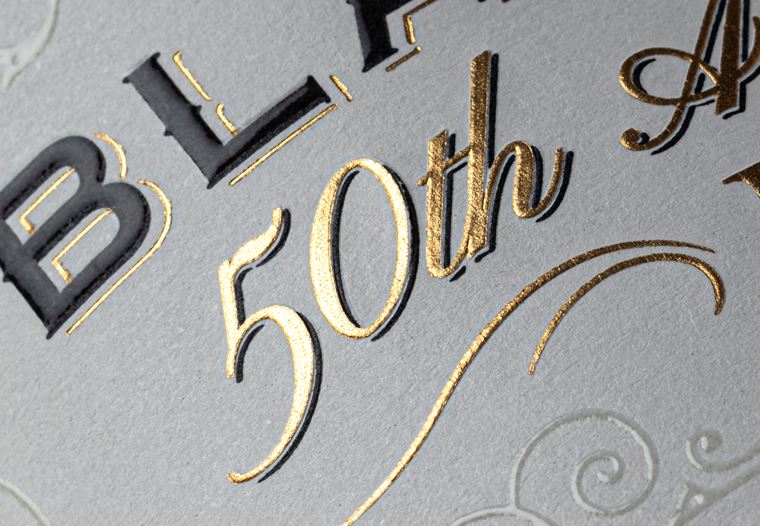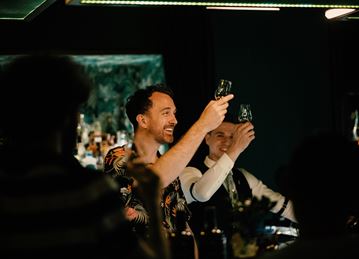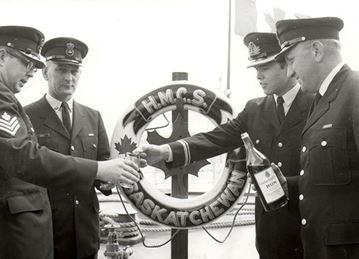

Tales of the Tot
Behind the Blend - Interview with Oliver Chilton, Black Tot Head Blender

Interview with Elixir Distillers/Black Tot Rum Head Blender, Oliver Chilton, by Mitch Wilson
Have you ever wondered how a rum blend comes together? In this interview we sit down with Oliver Chilton, Head Blender at Elixir Distillers, who has composed the blends for Black Tot Finest Caribbean, 50th Anniversary, and our latest release, Master Blender’s Reserve 2021. In addition to these rum blends, Oliver has many years of experience in blending and bottling whiskies such as Elements of Islay, Port Askaig, and Single Malts of Scotland under the Elixir Distillers flag. In this interview, we look at Oliver’s approach to blending, how Master Blender’s Reserve was created, and how he adapted his whisky skillset to the tropical world of rum…
Do you have an idea of where a blend is heading before you create it?
Yes and no. I will discuss different flavour concepts with my Managing Director before we start, so with 50th Anniversary we were looking to find a balance between traditional Navy-style rum, such as Black Tot Last Consignment, and our more contemporary, fruit-forward blend in Finest Caribbean. While on that journey, we start to find all sorts of different directions you can go. When we developed 50th Anniversary, one of the earlier iterations of that blend would later become the inspiration for Master Blender’s Reserve. Going forward with the annual Black Tot Day releases, we will always include a percentage of the previous blend which gives a nod to what we have done before, while also looking to showcase the incredible depth of flavour and character you can find by blending different styles of rum together.
Does this end goal evolve or change as you go through the process?
Blending, in a general sense, is very much a balance of luck and judgement. Flavours in different rums don’t always balance as you might expect which leads to some interesting consequences. There is a lot of ‘two steps forward, one step back’. When you are blending for consistency, such as we do with Black Tot Finest Caribbean, you have a very specific end flavour and style to reach, though to achieve this the recipe may change in small ways to take account of changes in spirit and wood. With something like Master Blender’s Reserve, while you may have an initial style in mind, you are more able to go on the journey with the rum and find new flavours and combinations that weren’t in your initial brief.
The Master Blender’s Reserve 2021 uses last year’s 50th Anniversary as the initial base rum - how does this affect your blending process?
Essentially it gives you a platform to start with. You know that these flavours are going to be part of the blend and then it is a case of working around this to achieve the end result you are looking for. With Master Blender’s Reserve 2021, we specifically wanted it to be more citrus driven and build on some of the more oily, fusel characters. We also know that we have to balance this idea against the rich liquorice and dense Demerara notes in 50th. For me, the challenge is to show a new interpretation of Navy Rum while balancing that with a nod to the past - keeping that percentage of last year’s rum in the blend helps us to do this.
How do you select which casks are going to be shortlisted for the blend?
To start with, we identify the characters we feel will help us find the specific flavours we are looking for. For example, we had tasted Beenleigh rum distilled in 2007 and knew it carried a great balance of citrus fruit while being quite oily and dense. We had also been recommended a small parcel of Trinidad rum that had some wonderful stone-fruit character. With that in mind, we get in representative samples of all the different styles we are looking to include and then essentially start messing around. It is not an exact science and there is a lot of adding something and then adjusting. Once we have our bench sample, we buy the casks that we require from each marque and vintage (along with a little extra) and then start the same process on a larger scale. Once we have our vat of rums, we taste it, and then start adjusting for the cask variations by adding from our spare stock.
Is cask variance the only thing that can cause issues when scaling up to the full vat, or does this scaling up process sometimes reveal more dominant flavours that didn’t present themselves in the test blend?
In theory both aspects could deliver differences and you are essentially adjusting for both. You also have things like how the cask can change in transit – for example, if you take a sample when the cask is lying and then you move it around, you will often find variances in the flavours you end up getting. There is also the time lag between your initial samples being taken and when you move the cask for vatting - this additional ageing will also affect the flavour.
Have you encountered times when scaling up where the blend has ended up tasting completely different to what you expected and you’ve needed to reset or balance things out again?
Only when the bottling hall added more Hampden than was required!
How long does the blending process usually take? From cask selection, to working out proportions, to marrying time?
In the case of Master Blender’s Reserve 2021 it took around six months, but we are already working on Master Blender’s Reserve 2022 – the more time we have, the better.
What are some of the greatest challenges you’ve faced when putting a blend together? How do you overcome these while still factoring in cost and delivery deadlines?
If you are looking at the triangle of quality, cost and time, we always sacrifice time first. I think that because we are family owned and driven from a position of flavour first, we rarely face challenges in regards to blending – it is more a journey and sometimes that journey takes you to an unexpected place. If you are happy to embrace that philosophy then there are no challenges, just a different opportunity to the one you had originally envisaged.
Coming from the whisky blending world, what are the main differences you find when approaching rum? Have you had to change your methods for rum?
I have always considered myself to be more of a whisky hobbyist than a blender – I have had the great fortune to spend time with some of the world’s greatest blenders and I have taken that opportunity to learn from them, but I am very much still on a journey of discovery. With regards to rum, I would say this doubly so. In whisky, I would say I have a good level of knowledge on the different styles of whisky and how they are created. I use that to help me identify the whiskies we work with and then essentially mess around until we have something that we (as a company) like to drink. For rum, it is a similar method, except I don’t have as full an understanding of the different marques and styles and how they have developed over the decades – this is just because I have worked with whisky for almost twenty years and with rum (in earnest) for only five.
The great thing with rum (similar to whisky) is the amount of help you get from around the industry in developing your understanding. Largely, it is a very open category and there is always someone there to help you understand.
The significant difference between the two categories that I have noticed (and please bear in mind how early on my rum journey I am compared to whisky) is that the range and breadth of different flavours found in whisky is huge, while in rum it is the extremities that are huge. What I mean by this is that while you can probably find a much larger range of flavours in a glass of whisky compared to a glass of rum, one style of rum will often be radically different to another and sometimes there is nothing between the two. In whisky you have so many different styles you can almost find a steady curve to follow in your journey of flavour. In some ways this makes blending rum a lot more fun as you can be trying to marry very different styles and flavours together.
Do you think there’s space for whisky drinkers to become rum fans as well? Has there been more curiosity from the whisky world with someone like yourself (renowned for whisky) doing a rum blend?
Whisky fans, in my experience, are just flavour fans. They love everything from weird and wonderful beer to champagne, so there is no reason for them not to find a rum they will love. It is a great category with a fantastic range of styles. Possibly the only barrier is that you don’t have one part of the category leading the charge to convert people. When most people say whisky they mean Scotch Whisky or Bourbon – these are tightly defined spirits with lots of different companies sharing information about the product that are easy to digest. When you say rum, you are referring to an entire world all with radically different ideas and it can make it difficult to identify exactly what style you like and how that is made and by who.
One thing that often gets highlighted with Black Tot 50th and Master Blender’s Reserve is the detail on the back label - is this something you find in whisky as well?
We couldn’t put the details that we have shared on Master Blender’s Reserve on a Scotch Whisky label as it would be against the labelling regulations set out by the SWA [Scotch Whisky Association]. This specifically refers to the age, as with Scotch Whisky you can only name the youngest age of the whisky in the blend. This was put in to stop companies saying that their blend contains 50 year old whisky, but not saying that it only makes up 1% of the blend, while the rest is all 3 year old. It is a broad, brushstroke rule, to make life easier for the people policing the rules. In rum, as there are no regulations covering what you can and can’t say on a blended rum, so we can actually be more transparent. The flip side of that is that it allows room for other brands, if they wanted to, to mislead customers. For us, however, we believe in our customers and their ability to understand what it is we are doing, so we are happy with the way things are in rum.
How do you decide on the proportions? How much does flavour vs. cost play an impact in your selections?
Flavour comes first with everything we do. Of course I have a price in mind, and I will tend to look at rums in this price bracket and build from there, but if the blend requires something older or more expensive to get us to where we need to be then that is what we do. When we started 50th Anniversary, the idea was for it to be more like £80RRP but we just couldn’t make the blend work without some of the older components. Similarly, with Master Blender’s Reserve 2021, we were hoping to use some of the younger Guyana rums we had tasted while working on 50th but in the end they didn’t deliver the body and we ended up with a much more expensive cask of rum distilled in 2003. In the end, if it doesn’t taste as good, you are not going to sell your rum just because it is £50 cheaper.
People might look at a blend and say ‘oh this only has 0.5% or 0.3% added’ - does it really make a difference?
Absolutely! To be honest, we only found out how much difference while messing around. Sukhinder wanted Master Blender’s Reserve 2021 to taste older, to have some of the flavours of dusty books and wooden floors that you get from rums like Last Consignment. We added a few drops to the glass and those flavours popped out of the glass. I think, with specific flavours, it is similar to how bitters work in your cocktail.
You talk about ‘messing around’ in the blend and going two steps forward and one step back. Are there any times with a blend where you find yourself at a dead end, and have to start again? Or are you always able to retrieve or balance the blend as you go? In the case of MBR, did you ever have to go back to 50th and rethink the approach entirely?
I rarely make just one blend at a time, it will normally be two or three different directions and somewhere between these is the direction we end up taking. From there it is very much just adding and subtracting to find the right balance for what we are looking for.
How did you come up with the name Master Blender’s Reserve?
I didn’t…. Though I imagine someone in marketing was reading Master and Commander and got carried away. I do, however, like the idea that we are keeping a small reserve of our rum each year and using that to create something new. It is a great nod to the traditional Navy Rum blend.
Is there anything you can share about future upcoming releases of MBR and the direction it might take?
I’m afraid not, though I love the idea of being able to create the flavours of Longmorn 1969 in rum! As I alluded to at the beginning, we do have a brief, but that is simply where the journey begins - now we are going to let the rums take us where they will and hopefully end up with something as good as (and maybe even better than) our Master Blender’s Reserve 2021.




